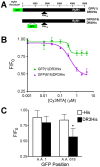Förster resonance energy transfer measurements of ryanodine receptor type 1 structure using a novel site-specific labeling method
- PMID: 19823671
- PMCID: PMC2757896
- DOI: 10.1371/journal.pone.0007338
Förster resonance energy transfer measurements of ryanodine receptor type 1 structure using a novel site-specific labeling method
Abstract
Background: While the static structure of the intracellular Ca(2+) release channel, the ryanodine receptor type 1 (RyR1) has been determined using cryo electron microscopy, relatively little is known concerning changes in RyR1 structure that accompany channel gating. Förster resonance energy transfer (FRET) methods can resolve small changes in protein structure although FRET measurements of RyR1 are hampered by an inability to site-specifically label the protein with fluorescent probes.
Methodology/principal findings: A novel site-specific labeling method is presented that targets a FRET acceptor, Cy3NTA to 10-residue histidine (His) tags engineered into RyR1. Cy3NTA, comprised of the fluorescent dye Cy3, coupled to two Ni(2+)/nitrilotriacetic acid moieties, was synthesized and functionally tested for binding to His-tagged green fluorescent protein (GFP). GFP fluorescence emission and Cy3NTA absorbance spectra overlapped significantly, indicating that FRET could occur (Förster distance = 6.3 nm). Cy3NTA bound to His(10)-tagged GFP, quenching its fluorescence by 88%. GFP was then fused to the N-terminus of RyR1 and His(10) tags were placed either at the N-terminus of the fused GFP or between GFP and RyR1. Cy3NTA reduced fluorescence of these fusion proteins by 75% and this quenching could be reversed by photobleaching Cy3, thus confirming GFP-RyR1 quenching via FRET. A His(10) tag was then placed at amino acid position 1861 and FRET was measured from GFP located at either the N-terminus or at position 618 to Cy3NTA bound to this His tag. While minimal FRET was detected between GFP at position 1 and Cy3NTA at position 1861, 53% energy transfer was detected from GFP at position 618 to Cy3NTA at position 1861, thus indicating that these sites are in close proximity to each other.
Conclusions/significance: These findings illustrate the potential of this site-specific labeling system for use in future FRET-based experiments to elucidate novel aspects of RyR1 structure.
Conflict of interest statement
Figures







References
-
- Wagenknecht T, Grassucci R, Frank J, Saito A, Inui M, et al. Three-dimensional architecture of the calcium channel/foot structure of sarcoplasmic reticulum. Nature. 1989;338:167–170. - PubMed
-
- Orlova EV, Serysheva II, van Heel M, Hamilton SL, Chiu W. Two structural configurations of the skeletal muscle calcium release channel. Nat Struct Biol. 1996;3:547–552. - PubMed
Publication types
MeSH terms
Substances
Grants and funding
LinkOut - more resources
Full Text Sources
Miscellaneous

